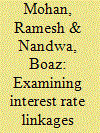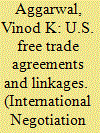|
|
|
Sort Order |
|
|
|
Items / Page
|
|
|
|
|
|
|
| Srl | Item |
| 1 |
ID:
090596


|
|
|
|
|
| Publication |
2009.
|
| Summary/Abstract |
Interest rates play an important role, not only in attracting capital inflow, but also in macroeconomic stabilization and determining asset prices. Given the interdependent nature of member countries of the Association of Southeast Asian Nations (ASEAN), it is crucial to examine whether there is any evidence of co-movement of short-term domestic interest rates within these economies. In addition, because of their significant economic influence in the region, we explore the Granger causality with China and India in determining their impact on interest rate movement in ASEAN-5 economies. We find evidence of cointegration; there is co-movement among the ASEAN interest rates. Further, based on the causality test, we find that China exerts more influence on the direction of the interest rates in the region.
|
|
|
|
|
|
|
|
|
|
|
|
|
|
|
|
| 2 |
ID:
088466


|
|
|
|
|
| Publication |
2009.
|
| Summary/Abstract |
We use a firm-level dataset for Chinese manufacturing, to estimate productivity spillovers from foreign direct investment (FDI) to local firms. The spillover channels considered include inter-firm labour turnover/mobility; vertical input-output linkages; exporting externalities; and horizontal effects. The roles of these channels are dependent on various factors including export propensity, R&D expenditure per capita, employee training, and ownership structure. We find that export of multinational enterprises (MNEs) is the most prominent spillover channel. Labour turnover and horizontal demonstration and competition bring positive spillovers to SOEs but not to local private firms. Vertical linkages are not found to be significant.
|
|
|
|
|
|
|
|
|
|
|
|
|
|
|
|
| 3 |
ID:
110786


|
|
|
|
|
| Publication |
2011.
|
| Summary/Abstract |
Intellectual property rights (IPRs) ultimately delineate the way in which knowledge is created, owned, controlled and diffused, domestically and now globally. They have always been contested because knowledge is both a form of capital and a public good, but these contests have become more acute since the WTO TRIPs Agreement came into force in 1995. As a result of new frames and linkages propelled by various actors between IPRs and other issue-areas, the current intellectual property regime has become complex and somewhat inconsistent. This article contributes to a better understanding of the concrete mechanisms and processes through which various global regimes come to overlap with each other in the area of IPRs, of the actors that are involved in these processes, as well as of the consequences of such developments for the governance of IPRs and global governance more generally.
|
|
|
|
|
|
|
|
|
|
|
|
|
|
|
|
| 4 |
ID:
120719


|
|
|
|
|
| Publication |
2013.
|
| Summary/Abstract |
Abstract This article examines the driving factors that account for patterns of linkages to broader economic, labor, environmental, and security issues in U.S. Free Trade Agreements (FTAs). Rather than only emphasizing trade benefits or security considerations as in much recent work on FTAs, this analysis provides a richer empirical picture by focusing on the full universe of U.S. FTAs. It conceptually differentiates among different issues that might be linked to FTAs and categorizes different patterns of U.S. FTAs based on the key issues that drove negotiations. The article then examines these negotiations from a theoretical standpoint, focusing on three elements. First, it examines the degree to which linkages in the U.S. domestic policymaking process are top-down or bottom-up. Second, it considers linkages types in terms of the underlying basis for issue connections - either power or knowledge. Third, it more briefly examines the bargaining process. The conceptual and theoretical analysis is buttressed through an examination of various illustrative cases of U.S. FTA negotiations to demonstrate the utility of this approach to illuminate the variety of 'linkage packages' that have driven U.S. FTAs. We conclude with the broader implications of linkages politics in FTAs.
|
|
|
|
|
|
|
|
|
|
|
|
|
|
|
|
|
|
|
|
|